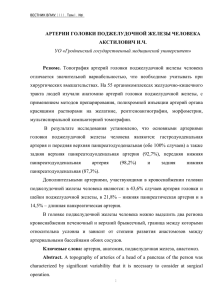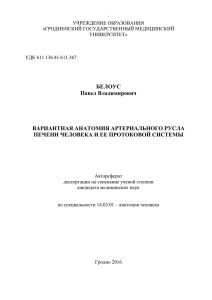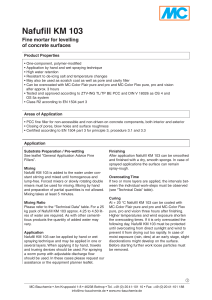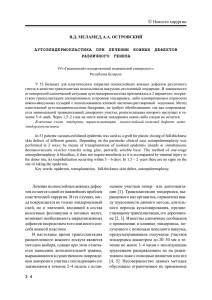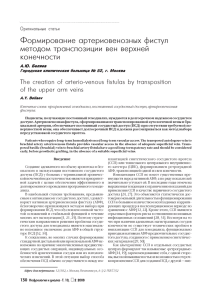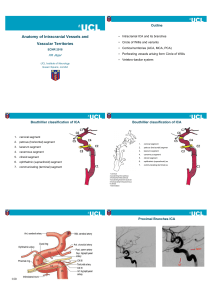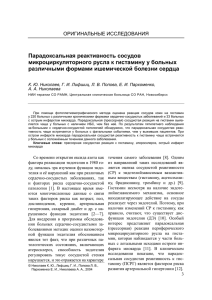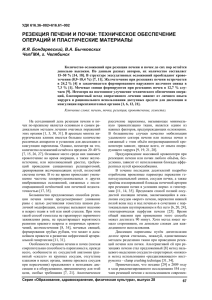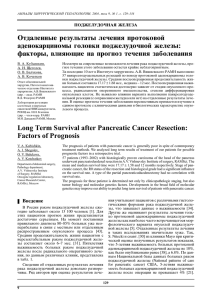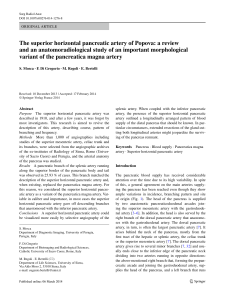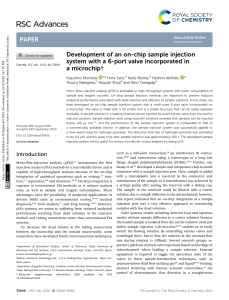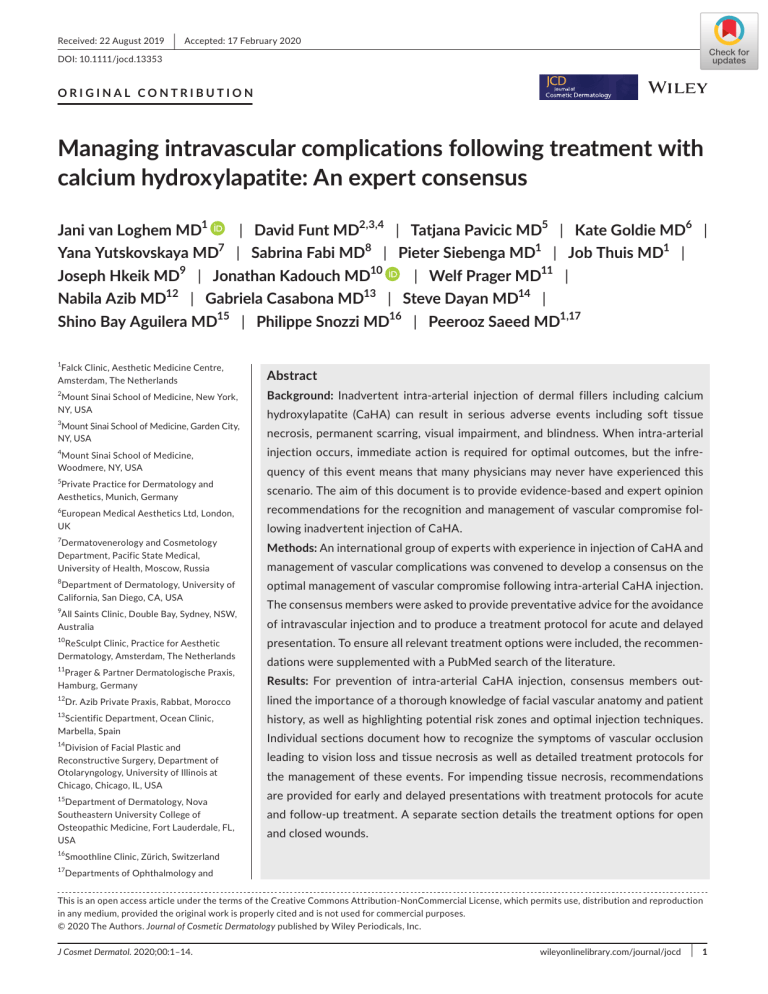
Received: 22 August 2019 | Accepted: 17 February 2020 DOI: 10.1111/jocd.13353 ORIGINAL CONTRIBUTION Managing intravascular complications following treatment with calcium hydroxylapatite: An expert consensus Jani van Loghem MD1 | David Funt MD2,3,4 | Tatjana Pavicic MD5 | Kate Goldie MD6 | Yana Yutskovskaya MD7 | Sabrina Fabi MD8 | Pieter Siebenga MD1 | Job Thuis MD1 | Joseph Hkeik MD9 | Jonathan Kadouch MD10 | Welf Prager MD11 | Nabila Azib MD12 | Gabriela Casabona MD13 | Steve Dayan MD14 | Shino Bay Aguilera MD15 | Philippe Snozzi MD16 | Peerooz Saeed MD1,17 1 Falck Clinic, Aesthetic Medicine Centre, Amsterdam, The Netherlands Abstract 2 Background: Inadvertent intra-arterial injection of dermal fillers including calcium Mount Sinai School of Medicine, New York, NY, USA 3 Mount Sinai School of Medicine, Garden City, NY, USA 4 Mount Sinai School of Medicine, Woodmere, NY, USA 5 Private Practice for Dermatology and Aesthetics, Munich, Germany 6 European Medical Aesthetics Ltd, London, UK 7 hydroxylapatite (CaHA) can result in serious adverse events including soft tissue necrosis, permanent scarring, visual impairment, and blindness. When intra-arterial injection occurs, immediate action is required for optimal outcomes, but the infrequency of this event means that many physicians may never have experienced this scenario. The aim of this document is to provide evidence-based and expert opinion recommendations for the recognition and management of vascular compromise following inadvertent injection of CaHA. Dermatovenerology and Cosmetology Department, Pacific State Medical, University of Health, Moscow, Russia Methods: An international group of experts with experience in injection of CaHA and 8 optimal management of vascular compromise following intra-arterial CaHA injection. Department of Dermatology, University of California, San Diego, CA, USA 9 All Saints Clinic, Double Bay, Sydney, NSW, Australia 10 ReSculpt Clinic, Practice for Aesthetic Dermatology, Amsterdam, The Netherlands 11 Prager & Partner Dermatologische Praxis, Hamburg, Germany 12 Dr. Azib Private Praxis, Rabbat, Morocco 13 Scientific Department, Ocean Clinic, Marbella, Spain 14 Division of Facial Plastic and Reconstructive Surgery, Department of Otolaryngology, University of Illinois at Chicago, Chicago, IL, USA 15 Department of Dermatology, Nova Southeastern University College of Osteopathic Medicine, Fort Lauderdale, FL, USA 16 Smoothline Clinic, Zürich, Switzerland 17 Departments of Ophthalmology and management of vascular complications was convened to develop a consensus on the The consensus members were asked to provide preventative advice for the avoidance of intravascular injection and to produce a treatment protocol for acute and delayed presentation. To ensure all relevant treatment options were included, the recommendations were supplemented with a PubMed search of the literature. Results: For prevention of intra-arterial CaHA injection, consensus members outlined the importance of a thorough knowledge of facial vascular anatomy and patient history, as well as highlighting potential risk zones and optimal injection techniques. Individual sections document how to recognize the symptoms of vascular occlusion leading to vision loss and tissue necrosis as well as detailed treatment protocols for the management of these events. For impending tissue necrosis, recommendations are provided for early and delayed presentations with treatment protocols for acute and follow-up treatment. A separate section details the treatment options for open and closed wounds. This is an open access article under the terms of the Creative Commons Attribution-NonCommercial License, which permits use, distribution and reproduction in any medium, provided the original work is properly cited and is not used for commercial purposes. © 2020 The Authors. Journal of Cosmetic Dermatology published by Wiley Periodicals, Inc. J Cosmet Dermatol. 2020;00:1–14. wileyonlinelibrary.com/journal/jocd | 1 2 | LOGHEM et al. Endocrinology, Orbital Center, Academic Medical Center, University of Amsterdam, Amsterdam, The Netherlands Conclusions: All physicians should be prepared for the eventuality of intra-arterial injection of a dermal filler, despite its rarity. These consensus recommendations combine advice from aesthetic experts with the latest reports from the published litera- Correspondence Jani van Loghem, Falck Clinic, Aesthetic Medicine Centre, Falckstraat 51, Amsterdam, The Netherlands. Email: [email protected] ture to provide an up-to-date office-based protocol for the prevention and treatment of complications arising from intra-arterial CaHA injection. KEYWORDS calcium hydroxylapatite, dermal filler, intra-arterial injection, safety, vascular compromise, vision loss 1 | I NTRO D U C TI O N 2 | CO N S E N S U S O B J EC TI V E S A N D M E TH O D O LO G Y In the past two decades, the popularity of injectable dermal fillers to correct aging-related soft tissue volume loss and contour CaHA is one of the most versatile dermal fillers with a long history of defects has increased dramatically. Along with neurotoxin injec- aesthetic use.16,17 It is widely used for indications ranging from vo- tions, these products represent the mainstay of most medical lumizing and contouring, and more recently in hyperdiluted form for aesthetic practices.1,2 Among the soft tissue fillers, hyaluronic skin rejuvenation.18-21 The risk of severe adverse events as a result acid (HA) products are most commonly used, followed by cal- of inadvertent intra-arterial injection is very rare, but all injectors ® cium hydroxylapatite (CaHA, Radiesse ; Merz North America, using this product should have an in-depth understanding of how Inc) and poly-L-lactic acid (Sculptra, Galderma ®).1,2 Although this may occur, how to avoid it, how to recognize it, how to limit these products are considered to be safe (within their approved vascular compromise should it occur, and how to treat the resulting indications and when injected by qualified professionals), the sequelae. The current recommendations have addressed this need potential risk for severe adverse events remains regardless of by bringing together a group of 17 international aesthetic experts the filler used. 3,4 with experience in injection of CaHA and the management of CaHA- In a cross-sectional review, the complication profile associated related complications. The format was slightly different from most with injectable fillers was evaluated by searching the databases of consensus papers in that there were no face-to-face meetings. The the US Food and Drug Administration (FDA) and Manufacturer and process was initiated in November 2018 when consensus members User facility Device Experience (MAUDE). From 2014 to 2016, a were asked to produce a treatment protocol for immediate and late total of 1748 adverse events were reported.5 Intra-arterial injections measures to be taken after intra-arterial injection of CaHA, and to without sequelae and those resulting in necrosis or blindness were give preventative advice for the avoidance of intravascular injec- considered severe complications and were reported in 220, 121, and tion. A comprehensive literature search was also conducted using 8 cases, respectively, the latter most commonly after dorsal nasal the PubMed database and the following search terms: calcium hy- injections. droxylapatite, Radiesse, vascular compromise, vascular occlusion, Vascular compromise and occlusion may occur with any dermal vascular necrosis, visual impairment, vision loss, and blindness; arti- filler following inadvertent intra-arterial injection, and it is gen- cles were limited to those published in English. A first draft was pre- erally the volume of product injected rather than filler type that pared based on the information collected and a draft circulated to has the greatest impact: The larger the bolus and the larger the the group for their comments and precision. Areas of disagreement branch of the artery that is embolized, the larger the area of ne- were identified and a questionnaire circulated allowing members to crosis. All injectors must be aware of the type of adverse events vote on contentious areas. that can occur and how to treat them. A comprehensive under- The current document represents the culmination of this pro- standing of facial anatomy and dermal filler characteristics is es- cess. In light of new scientific knowledge, treatments for filler-in- sential. Given the rarity of vascular compromise, physicians might duced vascular compromise are constantly improving. The aim of not have any experience in the recognition nor management of this paper was to collate all successful treatment options into one these complications. document and based on this information to provide an up-to-date For hyaluronic acid based fillers, a number of aesthetic physi- protocol for treatment based on expert consensus and the latest cians have proposed protocols for the management of vascular com- treatment techniques. Ethics approval was not required for this promise using hyaluronidase, 6-9 and several consensus documents consensus statement. The specific recommendations presented have been published.10-13 Treatment protocols have been proposed in this article represent the panel's expert opinion based on their for vascular compromise following CaHA injections,6,14,15 but to date collective clinical experience and published data regarding vascular no specific consensus guidelines exist. compromise with CaHA in the cosmetic setting. All patients whose | LOGHEM et al. images appear in this document provided written informed consent 3 3.1.2 | Risk zones to their use. Areas of the face that have the highest risk of vascular occlusion 2.1 | Calcium hydroxylapatite aesthetic indications are those with extensive anastomoses between vascular territories (Figure 1), because of the risk of occluding adjoining smaller diameter arteries, for example, central retinal artery,8 and those with a Approved aesthetic indications of CaHA are for facial soft tissue aug- poor source of collateral circulation,5,38,39 such as the end arteries of mentation including the correction of moderate-to-severe facial wrin- the nasal tip and alar (Table 1). Injections to the nasal area have been kles and folds, such as nasolabial folds and to correct volume loss in reported as the main cause of tissue necrosis and the second cause the dorsum of the hands. 22-24 With the recognition that facial aging of visual loss.40,41 occurs at all anatomical layers, expanded, albeit off-label indications, The glabella is a contraindication for CaHA, and the product for CaHA, have been developed that make use of its rheological prop- should not be injected here. The glabella is the most common filler erties, and in addition to soft tissue lifting, it is now also widely used to injection site triggering blindness as small vessels branching from the restore contours affected by age-associated bone resorption, replen- supratrochlear artery provide the blood supply to the glabellar region ish fat loss, and most recently in diluted form to improve skin laxity. The and connect to the central retinal artery via the ophthalmic artery. product's instructions for use warn that special care should be taken to In the area of the nasolabial fold and nasal dorsum, there are anasto- avoid injection into the vasculature, particularly in high-risk areas that moses between the facial, angular, and lateral nasal arteries (external are dependent on blood supply from a single arterial branch such as the carotid circulation) with the dorsal nasal artery, which is a branch glabellar, nose, and nasolabial folds.25 However, all facial arteries are of the ophthalmic artery (internal carotid circulation) (Figure 2).32 potentially vulnerable to intravascular injection and once the pressure Injection into the nasolabial fold or nasal dorsum may therefore ac- from injection has ceased, the product travels through the vasculature cidentally deliver product intra-arterially, and if plunger pressure is and may result in local or distal necrosis. Intravascular occlusion of fa- greater than arterial pressure, product can move proximally into the cial arteries is solely due to injector-dependent technical errors and central retinal artery. In the temporal region, anastomoses can exist can be avoided with a comprehensive knowledge of vascular anatomy between the frontal branch of the superficial temporal artery and and proper injection technique. the supraorbital, supratrochlear, and zygomaticotemporal arteries (Figure 2), thus allowing a filler to be propelled retrograde into the central retinal artery.32 3 | R E S U LT S To minimize risk, injections should always be performed slowly, with low volume and attention paid to the pain feedback received 3.1 | Prevention from the patient. Close to the supratrochlear and supraorbital foramina, no injection should be performed in the supraperiosteal and 3.1.1 | Anatomy and patient history subgaleal planes, respectively.42,43 A thorough discussion of the facial (three-dimensional arterial) anatomy relevant to dermal filler injections is beyond the scope 3.1.3 | Injection technique of this review, but the reader is referred to a series of publications based on anatomical dissections designed to promote safe For a detailed description of the anatomical planes that offer the patient outcomes after nonsurgical aesthetic treatment, a num- least arterial risk in injection danger zones, the reader is referred ber of which were co-authored by members of this consensus to the papers of Criollo-Lamilla et al and Cotofana & Lachman.33,44 group and are relevant to facial areas typically treated with CaHA Needles are no longer recommended for injecting the forehead. injections. 26-34 Studies have shown that injected product changes plane after nee- A complete patient medical history should be obtained at the dle injections and does not remain in the subgaleal (safe) plane.45 initial consultation including details of all previous aesthetic treat- This has been demonstrated with a range of needle sizes and with ments and surgery as these can alter the patient's baseline anatomy. injections performed at both perpendicular and oblique angles.46 A Physicians should also be aware that there are large variations be- recent cadaver study, which compared the forces required to pen- 35,36 etrate the facial arterial vasculature, found that all sizes of cannula Patients who have undergone previous cosmetic procedures such as with the exception of 27G required greater forces for intra-arterial rhinoplasty may have unpredictable repositioning of blood vessels penetration compared with correspondingly sized needles; 27G can- and a more tenuous blood supply in the operated area, which may in- nulas required a similar force to a 27G needle.34 Van Loghem et al47 crease the risk of ischemia, necrosis, and vascular embolism follow- suggest the use of a cannula when treating the frontal area and have ing the filler injection.37 Previous tissue scars may also fix arteries in published techniques for injections in this zone.43 tween individuals in the branching patterns of many arteries. place, making them easier to penetrate with small sharp needles or even cannulae. CaHA should be injected slowly, with a low injection force and with the smallest amount of product necessary. For deep injections, the 4 | LOGHEM et al. F I G U R E 1 Illustration of the main facial arteries and their anastomoses. (fb), frontal branch; (pb), parietal branch; AA, angular artery; ADTA, anterior deep temporal artery; CA, columellar artery; DNA, dorsal nasal artery; ECA, external carotid artery.; FA, facial artery; ILA, inferior labial artery; IOA, infraorbital artery; LNA, lateral nasal artery; MTA, middle temporal artery; PA, philtral artery; PDTA, posterior deep temporal artery; SLA, superior labial artery; SMA, submental artery; SOA, supraorbital artery; STA, superficial temporal artery; STRA, supratrochlear artery; TFA, transverse facial artery; ZFA, zygomaticofacial artery. Copyright Jani van Loghem, UMA-Institute.com periosteum remains the preferred location, but with caution as there without integrated lidocaine) showed negative test results with is no guarantee that injections will be extravascular or remain on the anticoagulated blood with a variety of needles (23-33G), even 46 Large boluses should be avoided and injection volumes after 10 seconds of aspiration with 0.5 mL negative pressure.48 limited to 0.1 mL. Although flow of product can be reduced by using CaHA with standard dilution (16.7% lidocaine) showed positive the smallest gauge needle size possible, small needle caliber increases test results within 1 second using needles of 27G or thicker with plunger pressure and the likelihood of clogging, which may cause the a 0.8 mL CaHA syringe and aspiration times of 3 seconds (27G, periosteum. injector to increase the pressure on the plunger and thus the risk of se- 13 mm and 25G, 13 mm) and 7 seconds (23G, 19 mm) with the 1.5- rious adverse events should the needle be intravascular. Large gauge mL syringe. Some research has suggested that a slow-pull retrac- needles increase the risk of bruising, but might decrease the risk of in- tion and up to 5 seconds waiting time may improve the reliability travascular injections. If unexpected resistance is detected, blanching of the aspiration test.49 observed, or the patient indicates pain, the injection must be stopped immediately. Aspiration test results are influenced by needle diameter, needle length, syringe, and rheological properties of the filler material, mak- Aspiration is often advocated as a method of avoiding intra- ing general remarks on reliability of aspiration difficult, other than vascular injection, the appearance of blood in the syringe indicat- to conclude that aspiration is unreliable.48,50 A blunt-tip cannula (22- ing the needle has entered an artery. However, it is important to 25G) and not a sharp needle should be used for injections in risk note that the absence of blood in the needle hub on aspiration is zones, for example, when in proximity to the foramina. no guarantee of avoidance. This has been demonstrated by the The use of blunt cannulae decreases the risk of intravascular results of a recent in vitro study where nondiluted CaHA (with and injection, but all cannulae (except the 10G size) can enter arteries | LOGHEM et al. TA B L E 1 5 Risk zones for injection Indication High risk Average risk Frontal area Frontal concavity [2] SOA (sf), STRA (sf) SOA (d), STA (d)a Supraperiosteal Periorbital area Brows [2] SOA (d) STA (frontal branch sf) Supraperiosteal, Glabella [3] Low risk Lowest risk anatomical level Area STA (d) Contraindicated Tear troughs [2] IOA (d), AA (sf) Supraperiostealb Palpebromalar groove [2] ZFA (d) Supraperiosteal Temporal area Temporal hollows [1] STA (sf), ADTA (d), PDTA (d) Nose Nasal tip [2] LNA (sf), CA (sf) Nasal dorsum [2] DNA (sf) Cheeks Mandibular area STA (if) Interfascialc Not recommended Supraperiosteal Alar [2] LNA (sf) Columella [2] CA (sf) Lateral cheek Not recommended Sub-SMAS ZFA (d), TFA (d) Supraperiosteal, subcutaneous Medial cheek IOA (d) FA (sf) AA (sf) Sub-SMAS, subcutaneous (diluted) Nasolabial folds SLA (d) FA (sf) AA (sf) Supraperiosteal Mandibular angle ECA (d) FA (d) Subcutaneous Pogonium ILA (d) Supraperiosteal, subcutaneous Mentum SMA(d), ILA (d) Supraperiosteal, subcutaneous Marionette lines SMA(d), ILA (d), FA (d) Subcutaneous Prejowl sulcus SMA(d), ILA (d), FA (d) Supraperiosteal, subcutaneous Note: Commonness of indication: [1] regular CaHA indication; [2]: not a common CaHA indication; and [3]: contraindication for CaHA. Usual depth of the artery: (sf): superficial: subcutaneous, (d): Deep: underneath the superficial musculo-aponeurotic system (SMAS), (if): interfascial. Arteries and their branches. Abbreviations: AA, angular artery; ADTA, anterior deep temporal artery; CA, columellar artery; DNA, dorsal nasal artery; ECA, external carotid artery; ILA, inferior labial artery; IOA, infraorbital artery; LNA, lateral nasal artery; PDTA, posterior deep temporal artery; SLA, superior labial artery; SMA, submental artery; SOA, supraorbital artery; STA, superficial temporal artery; STRA, supratrochlear artery; TFA, transverse facial artery; ZFA, zygomaticofacial artery. a Deep, subgaleal should be the safest plane of injection, but considering other risk factors like multi-level trajectory of the STRA and SOA in the 2 cm superior to the supraorbital rim not regarded as lower risk. b Even though this is theoretically correct, there are only 3 anatomical layers. The risk of CaHA ending up in the subcutaneous plane and being visible or causing malar edema is therefore significant. c Anatomically, the interfascial plane is avascular and therefore the safest. However, as the STA is attached to the temporoparietal fascia, this level is crossed by the cannula when traveling from the skin to the target plane and may therefore be less safe than the subcutaneous plane. and are therefore not 100% safe. 34,51 Cannulae 25G or larger re- needle so as not to deliver a large deposit in one location. The use of quire greater force to enter a vessel than a needle, while smaller adrenaline (epinephrine)-containing local anesthesia promotes arte- cannulae 27G and 30G are similar to needles. Parallel injections rial constriction, reducing the size of vessels and therefore the risk to the direction of the local arteries should be avoided as well of filler entry. However, products containing adrenaline may mask as using force through resistances that could contain arteries. blanching produced by occlusion.52 Tumescent injection, also known Areas where arteries have limited space to be pushed aside pose as saline hydrodissection, has been used successfully when perform- a particular risk, including postsurgical areas and neurovascular ing CaHA injections of the forehead.53,54 The tumescent solution for bundles. tissue hydrodissection creates a pocket of space for filler placement Other options to decrease the risk of vascular compromise include injecting in a retrograde fashion with a constantly moving and allows the physician to reduce bleeding and prevent vessel compromise. 6 | LOGHEM et al. F I G U R E 2 Possible pathways of central retinal artery embolization. AA, angular artery; CRA, central retinal artery; DNA, dorsal nasal artery; OS, ophthalmic artery; SOA, supraorbital artery; STA, supratrochlear artery. Red arrows: direction of blood flow; white arrows: direction of filler displacement. Copyright Jani van Loghem, UMA-Institute.com 3.2 | Vascular occlusion leading to vision loss of the intraocular pressure. The technique involves small rapid changes of intraocular pressure over a period of 1-3 hours, until all 3.2.1 | Recognizing the symptoms retinal emboli have been cleared from the vessel. Ocular massage is performed with the patient in a supine position, looking downward A disruption of the blood supply to the retina can occur after der- with their eyes closed.32 Gentle pressure is applied to the sclera mal filler injection in almost any area of the face and results in a of the anesthetized eye with a finger, indenting the globe by a few sudden onset of impairment/loss of vision accompanied by severe millimeters and then releasing at a frequency of 2-3 times a sec- pain (ocular, facial, and/or headache). Cerebral infarction can ac- ond.32,58 The prolonged, rapid small changes in intraocular pressure company retinal artery occlusion, and therefore, signs and symp- have been found to be more conducive to dislodging emboli than a toms such as aphasia or even contralateral hemiparesis might also brief high-pressure aggressive massage of the eye. The procedure be present. 55 should be continued until the patient reaches the treating ophthalmologist in the hospital. 3.2.2 | Management of impending vision loss An additional acute measure is to encourage the patient to “rebreathe” in a paper bag to increase carbon dioxide levels in the blood, which will cause the retinal arteries to vasodilate and could Once the retinal artery has been occluded, only a short window help dislodge the blockage.32,59 The patient should be given aspirin of opportunity of about 60 minutes exists before blindness is irre- 500 mg (Europe) or 625 mg (US) to avoid blood clotting upstream to versible (Figure 3).56 Only one case report has described a partial the CaHA embolus. vision recovery after CaHA-induced retinal artery occlusion, which Administration of a beta-adrenergic antagonist in the form of involved application of topical and systemic intraocular pressure eye drops (eg, timolol 0.5%), brinzolamide, or azetazolamide will also lowering agents, isovolemic hemodilution, ocular massage, and as- help to reduce intraocular pressure; azetazolamide may be of greater pirin anticoagulation, as well as carbon dioxide inhalation, oral cor- benefit if administered intravenously, and intravenous dexametha- ticosteroids, and hyperbaric oxygen therapy. 57 The patient must sone may be administered to decrease inflammation. These medi- be transferred immediately to the nearest ophthalmologist with as cations may be administered in the hospital as they are not readily much information as possible regarding the product, injection site(s), available in private clinics. and the volume of injection. Oral pentoxifylline at a dose of three 600 mg tablets daily has The goal is rapid reduction of intraocular pressure to allow the been shown to improve retinal flow more than placebo in patients emboli to dislodge downstream and improve retinal perfusion. with sudden loss of vision as a result of retinal vein thrombosis, al- Acute management involves eyeball massage to promote a lowering though no improvement in vision was demonstrated.60 LOGHEM et al. | (A) (B) FIGURE 3 Treatment algorithm for peripheral ischemia with impending vascular necrosis and retinal ischemia with impending vision loss 7 8 | LOGHEM et al. 3.3 | Vascular occlusion leading to tissue necrosis The area where the circulation of blood supply appears to be reduced should be flooded with hyaluronidase regardless of the filler 3.3.1 | Recognizing the symptoms type, due to its edema-reducing64,65 and anti-inflammatory properties.66 The amount of hyaluronidase will depend on the volume The incidence of impending necrosis following dermal filler treatment has been estimated as 1 in 100 000 cases (0.001%), 52 of CaHA injected. The hyaluronidase may be injected directly into al- the affected site. There was strong consensus for high doses (600U though consensus members felt this estimate was too optimistic of hyaluronidase for every 0.1 mL CaHA) in the affected area, with and in their experience was at least 1:10 000, particularly among aggressive treatment in the early stages following a vascular event. less experienced injectors and when long, sharp needles are rou- It is also important to check the reperfusion every 30-60 minutes tinely used. The usual initial presentation of vascular compromise posthyaluronidase treatment. If no improvement (eg, less blanching, and occlusion is a disproportionate pain to what can be expected. improvement of capillary refill) is seen within 60 minutes, additional However, the excessive pain may be masked due to the anes- quantities of a hyaluronidase should be injected every 2 hours (re- thetics mixed in certain fillers to an extent that in most cases, no peat 3-4 cycles). significant pain is perceived at all. Pallor and blanching usually Aspirin should be used to limit platelet aggregation, clot prop- present themselves immediately and follow the same pattern as agation, and further compromise, but should be given with an ant- the restricted blood supply pathway. A livedo reaction (mottled acid regimen for stomach protection. The recommended immediate discoloration) may follow in 1-10 minutes. Progressive symptoms treatment is with 650 mg (USA) or 500 mg (Europe, Canada) enter- include hemorrhagic changes (24-48 hours), blisters and pustules ic-coated aspirin.8 This should be followed by a maintenance dose (4-6 days), and necrosis (5-10 days) (Figure 4). Finally, secondary of 75 mg (USA) and 100 mg (Europe) for 3-5 days. Drugs such as infection may occur. sildenafil and tadalafil can be used to induce smooth muscle relax- In some cases, patients may not complain of symptoms or show ation, dilate blood vessels, and increase blood flow.14 Subcutaneous signs of ischemia during the filler injection or even on the day of the injection of a low molecular weight heparin such as nadroparin procedure.15,61 A possible explanation for this delayed onset is that (Fraxiparine) can be used to prevent thrombus formation proximal the filler is trapped at a bifurcation or branch point and becomes to the embolus and should be injected within 4 hours of the intra- dislodged at a later timepoint to cause an occlusion.62 vascular event.38 Injectors should also be aware of the potential for venous ob- Consensus was not achieved on the application of topical ni- struction as a result of compression when excessive amounts of filler troglycerin paste to facilitate vasodilation. Topical nitroglycerin are placed in a small area. Venous obstruction is generally associated may reduce tissue necrosis as a result of its vasodilatory proper- with a dull, aching pain and swelling, and a dark discoloration of the ties with the amount dependent on the size and area of impending affected area and can easily be misinterpreted and dismissed as early necrosis. However, animal studies have noted no improvement in discomfort and bruising after treatment.63 perfusion after topical application of nitroglycerin paste. 67 In addition, application is not without side effects, such as headaches, 3.3.2 | Management of vascular compromise and impending tissue necrosis hypotension, and dizziness. Coadministration of phosphodiesterase inhibitors with nitroglycerin is contraindicated as it can result in severe hypotension. At this time, no clear recommendations can therefore be made. Early presentation—acute treatment (up to 6 hours after onset of There was strong consensus for a tapering course of oral cor- symptoms, Figure 3) ticosteroids such as prednisone if tissue edema is present with a The goal is to rapidly re-instate blood flow and increase vasodi- suggested starting dose of 50 mg, tapering the dose every other lation in the affected area so treatment should commence with- day for a maximum of 7 days. Consensus members mention that out delay. Many of the steps will follow those recommended for even though edema is reduced using corticosteroids, there is no ev- impending necrosis after injection of a hyaluronic acid based idence that they have a positive effect on the outcome of ischemia product.10-13 after CaHA injection. There was also consensus on prescribing pro- In the presence of immediate pain and/or skin discoloration, or phylactic antiviral medication such as valaciclovir in patients with a as soon as the injector suspects the blood supply has been compro- history of herpes simplex virus and if the affected tissue involves mised, the injection must be stopped immediately and, if possible, the oral or nasal mucosa. aspiration of the product should be attempted before withdrawing the needle. Measures should then be implemented to improve blood Early presentation—treatment follow-up flow and dissipate the agent. Warm compresses should be applied If after 6 hours circulation remains poor, hyaluronidase, aspirin, and the area massaged to promote vasodilation and perfusion. tadalafil, and the prednisolone tapering course should be continued. Massage causes vasodilation and may be effective if a larger branch There are also a number of additional therapeutic measures that can of an artery is blocked, and filler material can be spread to a few be considered that may improve outcome of CaHA-induced impend- arterioles. ing necrosis. | LOGHEM et al. 9 F I G U R E 4 Sequence of events in the development of vascular necrosis (courtesy of David Funt). The patient suffered a facial artery embolization with ischemia of the ala following injection in the nasolabial fold, near the pyriform aperture, with CaHA using a sharp needle. Initially, she was treated with massage, warm compresses, oral sildenafil 50 mg daily for 4 d, nitroglycerin paste for 4 d, oral antibiotics, valaciclovir prophylaxis, and open treatment with aquaphor and twice-daily showering. This demonstrates that early debridement should be avoided because patients usually heal better than initially anticipated • Without signs of severe necrosis, there was no consensus on the treatments with a carbon dioxide laser, the combination of PRP use of systemic antibiotics. If the clinical picture of the ischemia with standard treatments for tissue necrosis appeared to acceler- suggests a favorable course, superinfection is very unlikely. ate scar resolution. • There was no consensus on the use of antibiotics with anti-in- • Red light therapy, for example, with a 640-nm light emitting diode flammatory properties like doxycycline to treat CaHA-induced (LED) red light source, can be used to decrease inflammation. ischemia as there is no published evidence to support this. This has been shown to improve vascular circulation and promote • There was consensus about the use of systemic antibiotics in wound healing for necrosis following breast reconstruction sur- the event of signs of severe necrosis. Some authors advised an- gery,72 and may be beneficial for impending filler-induced tissue tibiotics with a strong microbiological action like ciprofloxacin or necrosis.66 clarithromycin. • One of the consensus authors (SF) indicated that monopolar ra® • Pentoxyfilline (Trental ) 400 mg three times daily may accelerate diofrequency with a rolling method may be beneficial in dilating healing of soft tissue necrosis by improving erythrocyte flexibility blood vessels, but as there is no published evidence on this, ra- and increasing tissue oxygen levels.68 diofrequency is not included in the algorithm. • Hyperbaric oxygen therapy (oxygen therapy under pressure) should be considered.66,69 This has the potential to deliver oxygen All patients should be monitored closely for progress and for deep into the skin to oxygenate ischemic tissue, reduce edema, signs of infection. They must strictly avoid exposure to nicotine ei- and promote angiogenesis. It should be initiated in those cases ther from smoking tobacco, vaping, patches, or second hand smoke. where the involved tissue appears dusky the day after the event They should also avoid exposure to extreme cold as compromised despite the institution of the above measures. tissues are more prone to frostbite injury. • Another procedure that has been used successfully to promote Two of the consensus authors (YY and DF) have included case healing of necrotic tissue is the use of platelet-rich plasma (PRP). reports in this article describing the development of necrosis fol- PRP therapy involves drawing blood from the patient, running it lowing injection of CaHA for nasal bridge contouring and nasolabial through a centrifuge to obtain a plasma fraction with a concen- fold augmentation and their resolutions with a combination of the trated platelet count and high levels of cytokines and growth fac- procedures described above (Figures 4 and 5). tors, which are re-injected at the site of tissue injury. PRP has been shown to improve healing of wounds, tendons and bone.70 In one case report, PRP was injected intradermally and applied topically 3.4 | Delayed presentation to the skin of a 46-year-old woman who had developed necrosis on the glabella, forehead, and dorsum of the nose after injection Impending vascular compromise is not always recognized immedi- of hyaluronic acid filler 2 days previously.71 The patient was ini- ately, and some patients may present themselves more than 24 hours tially treated with hyaluronidase, oral antibiotics, and predniso- after the initial event. Treatment is still warranted as any attempt to lone, which could not prevent deterioration of the wound. After increase vasodilation and reduce inflammation will improve the out- debridement, the patient received PRP on the fourth day after the come. An aggressive therapy is required to re-establish new vessel onset of the adverse event. Although the patient required several formation and tissue oxygenation. In addition to the acute treatments 10 | LOGHEM et al. (A) (B) (C) (D) (E) (F) (G) (H) (I) (J) A female patient aged 34 years old with no skin pathologies or history of allergy was treated for correction of nasal bridge and skin of the columella with non-diluted CaHA. Injection was performed with a cannula 22G-70mm and a volume of 0.3 ml injected in nasal bridge and 0.2 ml in columella (A and B show patient before the procedure). A slight blanching in the upper lip area was observed after the procedure. The patient did not report any pain but had received local anesthesia. A reticulate livedo and cyanosis in the upper lip was observed 2 h after the procedure (C and D). The patient was diagnosed with embolism of one of the branches of the upper labial artery. The patient received hyaluronidase injection 1500 IU at a standard dilution of 2 ml of 0.9% NaCl solution and sildenafil 100 mg. The following day the patient complained of swelling, reduced sensitivity of the upper lip and blueness in this area (E). A further dose of sildenafil 100 mg was prescribed. On the third day after the procedure the patient complained of burning mucosa, increasing swelling, decreased activity of the lip, and numbness of the tip of the nose (F–H). Taking into account the negative dynamics, the following treatments were assigned: hyperbaric oxygen therapy (1 procedure lasting 30 min); hyaluronidase 1500 IU injections in the columella and upper lip (0.5 ml); intravenous infusion of pentoxifylline 400 mg per 250 ml of 0.9% NaCl solution for 1 h; dexamethasone intramuscular injection 12 mg; Solcoseryl® gel on the lip mucosa; and sildenafil 100 mg once daily. On the fourth day after the procedure the patients dynamics were more positive. The skin of the upper lip was pale pink, and swelling had decreased (I). The treatments above were repeated on days 4 and 5 after which the lip had greatly reduced in volume, skin was light pink in color, the mucosa was restored to its pink coloring, and numbness of the lips had decreased (J). The patient was actively observed for 2 weeks until there was complete resolution of the signs of ischemia F I G U R E 5 Case report documenting the development of necrosis following injection of CaHA for nasal bridge contouring and its resolution. Courtesy of Professor Yana Yutskovskaya | LOGHEM et al. 11 highlighted in Figure 3, patients should receive daily hyperbaric oxy- burden to the patient. Dressings that keep the wound moist should gen therapy sessions for 1-2 weeks. PRP therapy may need to be continue to be used until it is completely healed. A number of dif- continued weekly for several weeks to improve skin texture and ferent types of lasers have been used to improve scar appearance to soften the edge between the damaged and undamaged areas. including: pulsed dye laser, nonablative fractionated laser resurfac- At later stages, this may be combined with microneedling, or laser ing, and fractionated laser resurfacing.66 therapy. Meticulous wound care including regular wound cleansing Microneedling (collagen induction therapy) may be considered to and gentle debridement of the necrotic tissue is essential to reduce improve healing and reduce scar formation. This technique uses fine healing time and limit scar formation. needles to puncture the skin at various depths to create a controlled skin injury without damaging the epidermis.75 Each puncture cre- 3.5 | Treatment of open wounds ates a channel in the dermis that stimulates the release of growth factors and cytokines. In turn, these stimulate new collagen and elastin production along with angiogenesis. A number of automated The presence of necrotic tissue in a wound is a physical impedi- microneedling devices are available including dermal rollers and the ment to healing and a medium for bacterial growth. If dried serum more recently developed dermal stamps or pens. Microneedling can or other debris is present, it should be removed and clearly necrotic also be combined with other treatments including growth factors, tissue debrided. Debridement should be conservative never remov- vitamin C, and PRP to enhance its skin rejuvenation properties. It ing questionable tissue as the final outcome is generally better than is recommended to repeat treatment at 4-week intervals. Patients anticipated (Figure 3). Consensus was not achieved on the type of should be advised that the full cycle of collagen production is a slow, antibiotic. Some members felt therapy should be instituted with an multistage process that can take up to 10 months to achieve final agent that is of benefit for its anti-inflammatory effects as well as to results. prevent secondary infection, such as a tetracycline (eg, doxycycline), and others that one with a strong antimicrobial action was required such as ciprofloxacin. Yet others believed antibiotics should only be prescribed if there are severe signs of necrosis. If therapy is initi- 4 | D I S CU S S I O N A N D FU RTH E R CO N S I D E R ATI O N S ated, a switch to another antibiotic may be required after culture results. In addition to regular debridement of necrotic tissue, routine In this document, a group of international physicians with exper- wound care should involve adequate hydration, daily dressings, and tise in the treatment of dermal filler complications collaborated to monitoring for secondary infection. These steps could be performed develop a consensus on the management of vascular compromise in conjunction with hyperbaric oxygen therapy once or twice daily following treatment with CaHA based on their collective clinical ex- to improve ischemia and reduce tissue loss. Open therapy with a perience and the published literature. Although it remains rare, all bland ointment may be preferable initially as it allows daily clean- physicians should be equipped to recognize and manage this event ing of the wound with running water. Specialized dressings, such as either as a result of a treatment performed in their own practice, or those made of soft silicone film (eg, Mepitel Film) or hydrocolloid when dealing with patients referred to them for an adverse event gel sheets (eg, DuoDERM), maintain a moist environment and sup- resulting from a treatment elsewhere. The availability or doses of port autolytic debridement and can be changed every 2 days. They some of the treatments outlined in this consensus may vary by coun- are designed to protect fragile and sensitive skin and minimize risk try, and while the consensus document outlines the key steps to fol- of skin breakdown and should be applied until re-epithelialization is low, treatments may have to be adapted to what is locally available. complete. Care must be taken with closed dressings to avoid the risk What is essential is that diagnosis is rapid and treatment is initiated of superinfection. immediately. For open wounds that are not healing properly, PRP therapy While massage is generally recommended as one of the first may be useful for bringing a higher concentration of platelets to the steps following accidental intra-arterial injection to encourage blood wound site and fighting infection. Some case reports have described flow and remove any obstruction, consensus members warned that success with adipose-derived stem cell therapy harvested from each consideration should be given to the volume of injectate. With vol- patient's abdominal subcutaneous tissue for treating skin necrosis umes of CaHA <0.1 mL, distribution over a larger capillary network after filler injection.73,74 and into the venous system is likely to be beneficial. However, massage of bolus volumes greater than this might distribute the embolus 3.6 | Treatment of closed wounds over a larger capillary network increasing the area of compromised tissue. Therefore, as a preventative precaution, consensus members advise to limit bolus injection to 0.1 mL. If boluses of >0.1 mL were Due to the replacement of normal tissues by fibrous material, the injected into an artery, massage should be delayed until treatments healing process may result in scar formation in spite of debridement to dilate arteries have been administered. and aggressive dressing changes. Scars often cause contracture and Hyaluronidase is recommended for impending vascular compro- subsequent cosmetic disfigurement, which results in a traumatic mise regardless of whether an HA or CaHA filler was used because 12 | LOGHEM et al. of its edema-reducing properties, effects on capillary permeability, and anti-inflammatory properties, all of which combine to increase blood flow to the affected area and promote wound healing. While large volumes of hyaluronidase could also increase pressure on the tissue, consensus members believe that in reality this would be very limited and lymphatic drainage would remove most of the additional fluid from the affected area. 5 | CO N C LU S I O N S With this manuscript, the authors address the need for an expert consensus on the management of vascular occlusions following inadvertent intra-arterial injection of CaHA. Avoiding and treating vascular compromise require a detailed understanding of facial anatomy. Early recognition of vascular occlusion and rapid and aggressive treatment are required to avoid irreversible changes. All physicians performing these injections should have a well-stocked supply of recommended medication, treatment options, and devices for impending necrosis or vision loss. The availability of an up-todate, office-based protocol for the prevention and treatment of vascular-related complications is essential for the timely and effective resolution of complications. ORCID Jani van Loghem Jonathan Kadouch https://orcid.org/0000-0001-6720-7434 https://orcid.org/0000-0001-5543-5675 REFERENCES 1. American Society for Aesthetic Plastic Surgery (ASAPS). Cosmetic surgery national data bank statistics 2017. http://www.surge ry.org/sites/default/files/2014-Stats.pdf. Accessed November 18, 2018. 2. International Society of Aesthetic Plastic Surgery (ISAPS). ISAPS international survey on aesthetic/cosmetic procedures performed in 2017. https://www.isaps.org/wp-content/uploads/2019/03/ ISAPS_2017_International_Study_Cosmetic_Procedures_NEW.pdf. Accessed May 19, 2019. 3. Hanke CW, Redbord KP. Safety and efficacy of poly-L-lactic acid in HIV lipoatrophy and lipoatrophy of aging. J Drugs Dermatol. 2007;6(2):123-128. 4. Kadouch JA. Calcium hydroxylapatite: a review on safety and complications. J Cosmet Dermatol. 2017;16(2):152-161. 5. Rayess HM, Svider PF, Hanba C, et al. A cross-sectional analysis of adverse events and litigation for injectable fillers. JAMA Facial Plast Surg. 2018;20(3):207-214. 6. Dayan SH, Arkins JP, Mathison CC. Management of impending necrosis associated with soft tissue filler injections. J Drugs Dermatol. 2011;10:1007-1012. 7. Beleznay K, Humphrey S, Carruthers JD, Carruthers A. Vascular compromise from soft tissue augmentation experience with 12 cases and recommendations for optimal outcomes. J Clin Aesthet Dermatol. 2014;7(9):37-43. 8. DeLorenzi C. Complications of injectable fillers, part 2: vascular complications. Aesthet Surg J. 2014;34(4):584-600. 9. Snozzi P, Van Loghem JAJ. Complication management following rejuvenation procedures with hyaluronic acid fillers—an algorithm-based approach. Plast Reconstr Surg Glob Open. 2018;6:e2061. 10. Cohen JL, Biesman BS, Dayan SH, et al. Treatment of hyaluronic acid filler-induced impending necrosis with hyaluronidase: consensus recommendations. Aesthet Surg J. 2015;35(7):844-849. 11. King M, Convery C, Davies E. The use of hyaluronidase in aesthetic practice. J Clin Aesthet Dermatol. 2018;11(6):428-434. 12. DeLorenzi C. Complications of injectable fillers, part I. Aesthet Surg J. 2013;33(4):561-575. 13. DeLorenzi C. New high dose pulsed hyaluronidase protocol for hyaluronic acid filler vascular adverse events. Aesthetic Surg J. 2017;37:1-12. 14. Beer K, Downie J, Beer J. A treatment protocol for vascular occlusion from particulate soft tissue augmentation. J Clin Aesthet Dermatol. 2012;5:44-47. 15. Tracy L, Ridgway J, Nelson JS, et al. Calcium hydroxylapatite associated soft tissue necrosis: a case report and treatment guideline. J Plast Reconstr Aesthet Surg. 2014;67:564-568. 16. Pavicic T. Calcium hydroxylapatite filler: an overview of safety and tolerability. J Drugs Dermatol. 2013;12(9):996-1002. 17. Van Loghem JV, Yutskovskaya YA, Philip WW. Calcium hydroxylapatite: over a decade of clinical experience. J Clin Aesthet Dermatol. 2015;8(1):38-49. 18. Yutskovskaya YA, Kogan EA. Improved neocollagenesis and skin mechanical properties after injection of diluted calcium hydroxylapatite in the neck and décolletage: a pilot study. J Drugs Dermatol. 2017;16(1):68-74. 19. Chao YY, Kim JW, Kim JS, Ko H, Goldie K. Hyperdilution of CaHA fillers for the improvement of age and hereditary volume deficits in East Asian patients. Clin Cosmet Investig Dermatol. 2018;11:357-363. 20. Goldie K, Peeters W, Alghoul M, et al. Global consensus guidelines for the injection of diluted and hyperdiluted calcium hydroxylapatite for skin tightening. Dermatol Surg. 2018;44(Suppl 1):S32-S41. 21. de Almeida AT, Figueredo V, da Cunha ALG, et al. Consensus recommendations for the use of hyperdiluted calcium hydroxyapatite (Radiesse) as a face and body biostimulatory agent. Plast Reconstr Surg Glob Open. 2019;7(3):e2160. 22. Smith S, Busso M, McClaren M, Bass LS. A randomized, bilateral, prospective comparison of calcium hydroxylapatite microspheres versus human-based collagen for the correction of nasolabial folds. Dermatol Surg. 2007;33(Suppl 2):S112-121. 23. Bass LS, Smith S, Busso M, McClaren M. Calcium hydroxylapatite (Radiesse) for treatment of nasolabial folds: long-term safety and efficacy results. Aesthet Surg J. 2010;30:235-238. 24. Goldman MP, Moradi A, Gold MH, et al. Calcium hydroxylapatite dermal filler for treatment of dorsal hand volume loss: results from a 12-month, multicenter, randomized, blinded trial. Dermatol Surg. 2018;44(1):75-83. 25. Radiesse® injectable inplant. Instructions for use, 2013. https:// www.radies se.com/wp-conten t/upload s/RADIES SE_Wrinkl e_ Filler_Instructions_for_Use.pdf. Accessed May 24, 2019. 26. Sykes JM, Cotofana S, Trevidic P, Solish N, Carruthers J, Carruthers A. Upper face: clinical anatomy and regional approaches with injectable fillers. Plast Reconstr Surg. 2015;136(5 Suppl):204S-218S. 27. Cotofana S, Schenck TL, Trevidic P, et al. Midface: clinical anatomy and regional approaches with injectable fillers. Plast Reconstr Surg. 2015;136(5 Suppl):219S-234S. 28. Cotofana S, Fratila AA, Schenck TL, et al. The anatomy of the aging face: a review. Facial Plast Surg. 2016;32(3):253-260. 29. Cotofana S, Mian A, Sykes JM, et al. An update on the anatomy of the forehead compartments. Plast Reconstr Surg. 2017;139(4):864e-872e. 30. Schenck TL, Koban KC, Schlattau A, Frank K, Sclafani AP, Giunta RE. Updated anatomy of the buccal space and its implications for plastic, reconstructive and aesthetic procedures. J Plast Reconstr Aesthet Surg. 2018;71(2):162-170. LOGHEM et al. 31. Suwanchinda A, Rudolph C, Hladik C, et al. The layered anatomy of the jawline. J Cosmet Dermatol. 2018;17(4):625-631. 32. Thanasarnaksorn W, Cotofana S, Rudolph C, Kraisak P, Chanasumon N, Suwanchinda A. Severe vision loss caused by cosmetic filler augmentation: case series with review of cause and therapy. J Cosmet Dermatol. 2018;17(5):712-718. 33. Cotofana S, Lachman N. Arteries of the face and their relevance for minimally invasive facial procedures: an anatomical review. Plast Reconstr Surg. 2019;143(2):416-426. 34. Pavicic T, Webb KL, Frank K, Gotkin RH, Tamura B, Cotofana S. Arterial wall penetration forces in needles versus cannulas. Plast Reconstr Surg. 2019;143(3):504e-512e. 35. Lohn JW, Penn JW, Norton J, Butler PE. The course and variation of the facial artery and vein: implications for facial transplantation and facial surgery. Ann Plast Surg. 2011;67(2):184-188. 36. Koh KS, Kim HJ, Oh CS, Chung IH. Branching patterns and symmetry of the course of the facial artery in Koreans. Int J Oral Maxillofac Surg. 2003;32(4):414-418. 37. Robati RM, Moeineddin F, Almasi-Nasrabadi M. The risk of skin necrosis following hyaluronic acid filler injection in patients with a history of cosmetic rhinoplasty. Aesthet Surg J. 2018;38(8):883-888. 38. Glaich AS, Cohen JL, Goldberg LH. Injection necrosis of the glabella: protocol for prevention and treatment after use of dermal fillers. Dermatol Surg. 2006;32(2):276-281. 39. Li X, Du L, Lu JJ. A novel hypothesis of visual loss secondary to cosmetic facial filler injection. Ann Plast Surg. 2015;75(3):258-260. 40. Ozturk CN, Li Y, Tung R, Parker L, Peck Piliang M, Zins JE. Complications following injection of soft-tissue fillers. Aesthet Surg J. 2013;33(6):862-877. 41. Scheuer JF 3rd, Sieber DA, Pezeshk RA, et al. Anatomy of the facial danger zones: maximizing safety during soft-tissue filler injections. Plast Reconstr Surg. 2017;139(1):50e-58e. 42. Khan TT, Colon-Acevedo B, Mettu P, DeLorenzi C, Woodward JA. An anatomical analysis of the supratrochlear artery: considerations in facial filler injections and preventing vision loss. Aesthet Surg J. 2017;37(2):203-208. 43. Van Loghem JAJ. Use of calcium hydroxylapatite in the upper third of the face: retrospective analysis of techniques, dilutions and adverse events. J Cosmet Dermatol. 2018;17:1025-1030. 44. Criollo-Lamilla G, DeLorenzi C, Trevidic P. Filler complications: is there a way to prevent vascular compromise with 3D-anatomy? PMFA J. 2017;5(1). https://www.thepmfajournal.com/features/ post/filler-compli catio ns-is-there- a-way-to-preven t-vascul arcompromise-with-3d-anatomy. 45. Pavicic T, Frank K, Erlbacher K, et al. Precision in dermal filling: a comparison between needle and cannula when using soft tissue fillers. J Drugs Dermatol. 2017;16(9):866-872. 46. Pavicic T, Mohmand HM, Yankova M, et al. Influence of needle size and injection angle on the distribution pattern of facial soft tissue fillers. J Cosmet Dermatol. 2019;18:1230-1236. 47. Van Loghem JA, Humzah D, Kerscher M. Cannula versus sharp needle for placement of soft tissue fillers: an observational cadaver study. Aesthet Surg J. 2016;38(1):73-88. 48. Van Loghem JAJ, Fouché JJ, Thuis J. Sensitivity of aspiration as a safety test before injection of soft tissue fillers. J Cosmet Dermatol. 2018;17(1):39-46. 49. Carey W, Weinkle S. Retraction of the plunger on a syringe of hyaluronic acid before injection: are we safe? Dermatol Surg. 2015;41(Suppl 1):S340-S346. 50. Casabona G. Blood aspiration test for cosmetic fillers to prevent accidental intravascular injection in the face. Dermatol Surg. 2015;41:841-847. 51. Yeh L, Fabi SG, Welsh K. Arterial penetration with blunt-tipped cannulas using injectables: a false sense of safety? Dermatol Surg. 2017;43(3):464-467. | 13 52. Narins RS, Jewell M, Rubin M, et al. Clinical conference: management of rare events following dermal fillers—focal necrosis and angry red bumps. Dermatol Surg. 2006;32:426-434. 53. Chao YY. Saline hydrodissection: a novel technique for the injection of calcium hydroxylapatite fillers in the forehead. Dermatol Surg. 2018;44(1):133-136. 54. Kim J. Novel forehead augmentation strategy: forehead depression categorization and calcium-dydroxyapatite filler delivery after tumescent injection. PRS Global Open. 2018;6:e1858. 55. Lazzeri D, Agostini T, Figus M, Nardi M, Pantaloni M, Lazzeri S. Blindness following cosmetic injections of the face. Plast Reconstr Surg. 2012;129:995. 56. Loh KT, Chua JJ, Lee HM, et al. Prevention and management of vision loss relating to facial filler injections. Singapore Med J. 2016;57(8):438-443. 57. Hsiao SF, Huang YH. Partial vision recovery after iatrogenic retinal artery occlusion. BMC Ophthalmol. 2014;14:120. 58. Baker DL. Gentle, prolonged ocular massage can restore vision after retinal artery occlusion. Healio.com website. Ocular Surgery News U.S. https://www.healio.com/ophthalmology/retina-vitre ous/news/print/ocular-surger y-news/%7b39ac 5b8e-e0c2-4e4a9df4-cf1b1a77f289%7d/gentle -prolon ged-ocular-massage-canrestore-vision-after-retinal-artery-occlusion Edition. July 1, 2004. Accessed December 1, 2018. 59. Walker L, King M. This month’s guideline: visual loss secondary to cosmetic filler injection. J Clin Aesthet Dermatol. 2018;11(5):E53-E55. 60. De Sanctis MT, Cesarone MR, Belcaro G, et al. Treatment of retinal vein thrombosis with pentoxifylline: a controlled, randomized trial. Angiology. 2002;53(Suppl 1):S35-38. 61. Bravo BS, De Almeida Balassiano LK, Da Rocha CR, et al. Delayedtype necrosis after soft-tissue augmentation with hyaluronic acid. J Clin Aesthet Dermatol. 2015;8(12):42-47. 62. DeLorenzi C. Transarterial degradation of HA filler by hyaluronidase. Dermatol Surg. 2014;40(8):832-841. 63. Sclafani AP, Fagien S. Treatment of injectable soft tissue filler complications. Dermatol Surg. 2009;35:1672-1680. 64. Engstrom-Laurent A, Feltelius N, Hallgren R, et al. Raised serum hyaluronate levels in scleroderma: an effect of growth factor induced activation of connective tissue cells? Ann Rheum Dis. 1985;44:614-620. 65. Dayan SH. Complications from toxins and fillers in the dermatology clinic. Recognition, prevention and treatment. Facial Plast Surg Clin North Am. 2013;21:663-673. 66. Darling MD, Peterson JD, Fabi SG. Impending necrosis after injection of hyaluronic acid and calcium hydroxylapatite fillers: report of 2 cases treated with hyperbaric oxygen therapy. Dermatol Surg. 2014;40(9):1049-1052. 67. Futran ND, Trotti A, Gwede C. Pentoxifylline in the treatment of radiation-related soft tissue injury: preliminary observations. Laryngoscope. 1997;107(3):391-395. 68. Henderson R, Reilly DA, Cooper JS. Hyperbaric oxygen for ischemia due to injection of cosmetic fillers: case report and issues. Plast Reconstr Surg Glob Open. 2018;6(1):e1618. 69. Hwang CJ, Morgan PV, Pimentel A, Sayre JW, Goldberg RA, Duckwiler G. Rethinking the role of nitroglycerin ointment in ischemic vascular filler complications: an animal model with ICG imaging. Ophthalmic Plast Reconstr Surg. 2016;32(2):118-122. 70. Chicharro-Alcantara D, Rubio-Zaragoza M, Damia-Gimenez E, et al. Platelet rich plasma: new insights for cutaneous wound healing management. J Funct Biomater. 2018;9:10. 71. Kang BK, Kang IJ, Jeong KH, Shin MK. Treatment of glabella skin necrosis following injection of hyaluronic acid filler using platelet-rich plasma. J Cosmet Laser Ther. 2016;18(2):111-112. 72. Yoon SM, Park YG, Park ES, Choi CY. Application of nipple-areolar complex impending necrosis with light-emitting diode treatment for 14 | immediate breast reconstruction after nipple-sparing mastectomy. Medical Lasers. 2017;6(1):5-9. 73. Sung HM, Suh IS, Lee H-B, Tak KS, Moon KM, Jung MA. Case reports of adipose-derived stem cell therapy for nasal skin necrosis after filler injection. Arch Plast Surg. 2012;39(1):51-54. 74. Kim JH, Park SH, Lee BH, Jeong HS, Yang HJ, Suh IS. Early Intervention with highly condensed adipose-derived stem cells for complicated wounds following filler injections. Aesthetic Plast Surg. 2016;40(3):428-434. 75. Aust MC, Fernandes D, Kolokythas P, Kaplan HM, Vogt PM. Percutaneous collagen induction therapy: an alternative LOGHEM et al. treatment for scars, wrinkles, and skin laxity. Plast Reconstr Surg. 2008;121:1421-1429. How to cite this article: van Loghem J, Funt D, Pavicic T, et al. Managing intravascular complications following treatment with calcium hydroxylapatite: An expert consensus. J Cosmet Dermatol. 2020;00:1–14. https://doi.org/10.1111/jocd.13353
